Alfa Romeo Junior vs DS Automobiles DS 3 – Which one offers the better deal?
Compare performance, boot capacity, efficiency and price at a glance.
Find out which car is the better choice for you – Alfa Romeo Junior or DS Automobiles DS 3?
Alfa Romeo Junior vs. DS Automobiles DS 3: A Modern Automotive Duel
The automotive landscape is continually evolving, and two of the standout contenders in the compact SUV segment for 2024 are the Alfa Romeo Junior and the DS Automobiles DS 3. Both cars offer unique features and specifications that cater to different preferences and driving styles. Let’s dive deep into the technical aspects and innovations that set these vehicles apart.
Design and Aesthetics
Starting with design, the Alfa Romeo Junior boasts the iconic Italian styling that the brand is renowned for. Its sleek lines and muscular stance give it a sporty appearance while still being practical for urban conditions. On the other hand, the DS Automobiles DS 3 boasts a more avant-garde aesthetic with sophisticated details and a bold front fascia. Both vehicles come with five doors and a spacious cabin designed to accommodate five passengers comfortably.
Powertrain and Performance
The Alfa Romeo Junior is equipped with a range of powertrains, including electric, petrol MHEV, and a remarkable 280 HP variant. It offers a 0-100 km/h acceleration time as quick as 5.9 seconds for the most potent configuration. The model features a variety of engine options, including a 1.2L three-cylinder engine, appealing to drivers looking for efficiency and performance. In terms of fuel consumption, it offers an impressive figure, with a petrol variant reaching as low as 4.5 L/100 km.
In comparison, the DS Automobiles DS 3 features a selection of diesel, petrol MHEV, and electric engines, topping out at 156 HP. The acceleration is slightly slower, clocking at 9.1 seconds from 0-100 km/h. Although its fuel consumption is marginally higher, at around 5 L/100 km for the petrol variant, the DS 3 maintains competitive efficiency with a well-balanced torque output, making it a solid contender for those prioritizing power with sophistication.
Electric Range and Battery Performance
Both models showcase impressive electric capabilities, with the Alfa Romeo Junior offering an electric range of up to 410 km and a battery capacity of 51 kWh. This aligns well with the growing trend towards sustainability among consumers. DS 3 also features the same battery capacity but has an electric range slightly lower at 400 km, making both vehicles suitable for urban commutes without frequent charging.
Ride Comfort and Quality
When it comes to ride comfort, the Junior maintains a curb weight of around 1620 kg, delivering a stable ride. The DS 3 is slightly lighter, sitting between 1249 kg and 1646 kg, which allows for agile handling and responsive driving. In terms of interior quality, the DS 3 heavily focuses on luxury materials and advanced technology, accentuated by premium finishes that enhance the overall driving experience.
Technological Innovations
Both vehicles highlight advanced technology features suited for modern-day driving. The Alfa Romeo Junior includes a robust infotainment system paired with intuitive connectivity options. It positions itself as more than just a stylish SUV, equipped with smart driving aids that enhance safety.
Conversely, the DS 3 showcases its commitment to innovation with an expansive infotainment system that integrates seamlessly with smartphone applications. The vehicle comes with features like adaptive cruise control, parking assistance, and a digital cockpit that drivers can customize to their preferences.
Conclusion: Which One Should You Choose?
Ultimately, the choice between the Alfa Romeo Junior and the DS Automobiles DS 3 comes down to individual preferences. If style and sporty performance are your priorities, the Alfa Romeo Junior shines with its powertrain options and unmistakable Italian flair. In contrast, if luxury and advanced technology are at the forefront of your decision-making process, the DS Automobiles DS 3 presents a compelling package.
Both vehicles stand as testament to the incredible innovation present in today’s automotive market, offering drivers a perfect blend of style, performance, and technology as we move into 2024.
Here’s where it gets real: The technical differences in detail
Costs and Efficiency: Looking at overall running costs, both models reveal some interesting differences in everyday economy.
Alfa Romeo Junior has a slightly advantage in terms of price – it starts at 25700 £, while the DS Automobiles DS 3 costs 28400 £. That’s a price difference of around 2777 £.
Fuel consumption also shows a difference: the Alfa Romeo Junior manages with 4.80 L and is therefore slight more efficient than the DS Automobiles DS 3 with 5 L. The difference is about 0.20 L per 100 km.
In terms of energy consumption, the advantage goes to the Alfa Romeo Junior: with 15.10 kWh per 100 km, it’s minimal more efficient than the DS Automobiles DS 3 with 15.50 kWh. That’s a difference of about 0.40 kWh.
As for range, the Alfa Romeo Junior performs minimal better – achieving up to 410 km, about 10 km more than the DS Automobiles DS 3.
Engine and Performance: Power, torque and acceleration say a lot about how a car feels on the road. This is where you see which model delivers more driving dynamics.
When it comes to engine power, the Alfa Romeo Junior has a significantly edge – offering 280 HP compared to 156 HP. That’s roughly 124 HP more horsepower.
In acceleration from 0 to 100 km/h, the Alfa Romeo Junior is decisively quicker – completing the sprint in 5.90 s, while the DS Automobiles DS 3 takes 9.10 s. That’s about 3.20 s faster.
In terms of top speed, the Alfa Romeo Junior performs barely noticeable better – reaching 206 km/h, while the DS Automobiles DS 3 tops out at 196 km/h. The difference is around 10 km/h.
There’s also a difference in torque: the Alfa Romeo Junior pulls clearly perceptible stronger with 345 Nm compared to 260 Nm. That’s about 85 Nm difference.
Space and Everyday Use: Beyond pure performance, interior space and usability matter most in daily life. This is where you see which car is more practical and versatile.
Both vehicles offer seating for 5 people.
In curb weight, the DS Automobiles DS 3 is somewhat lighter – 1249 kg compared to 1380 kg. The difference is around 131 kg.
In terms of boot space, the Alfa Romeo Junior offers to a small extent more room – 415 L compared to 350 L. That’s a difference of about 65 L.
In maximum load capacity, the Alfa Romeo Junior performs to a small extent better – up to 1280 L, which is about 230 L more than the DS Automobiles DS 3.
When it comes to payload, DS Automobiles DS 3 minimal takes the win – 466 kg compared to 420 kg. That’s a difference of about 46 kg.
All in all, the Alfa Romeo Junior shows itself to be is largely superior and secures the title of DriveDuel Champion.
It impresses with the more balanced overall package and proves to be the more versatile companion for everyday use.
Alfa Romeo Junior
The Alfa Romeo Junior captures the essence of Italian design with its sleek lines and compact dimensions, making it an icon of elegance and performance. With a spirited driving experience and a charming retro aesthetic, it appeals to enthusiasts and casual drivers alike. This delightful car embodies the brand's rich heritage while remaining a fun and engaging option for those seeking a unique automotive experience.
details @ media.stellantis.com
@ media.stellantis.com
 @ media.stellantis.com
@ media.stellantis.com
 @ media.stellantis.com
@ media.stellantis.com
DS Automobiles DS 3
The DS 3 stands out in the compact hatchback segment with its chic design and distinctive styling, making it a popular choice for those seeking a blend of elegance and individuality. Inside, the car boasts a premium interior that emphasizes comfort and cutting-edge technology, creating a delightful driving experience. With its agile handling and spirited performance, the DS 3 is not just about looks; it delivers on the road, ensuring a fun ride for enthusiasts and casual drivers alike.
details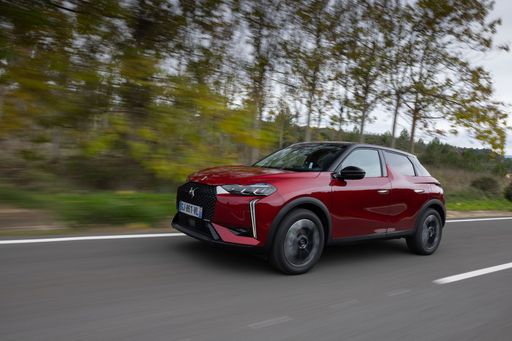 @ media.stellantis.com
@ media.stellantis.com
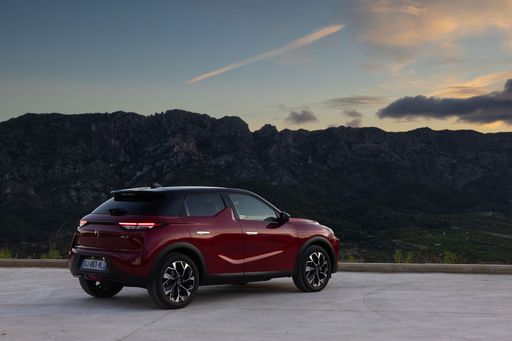 @ media.stellantis.com
@ media.stellantis.com
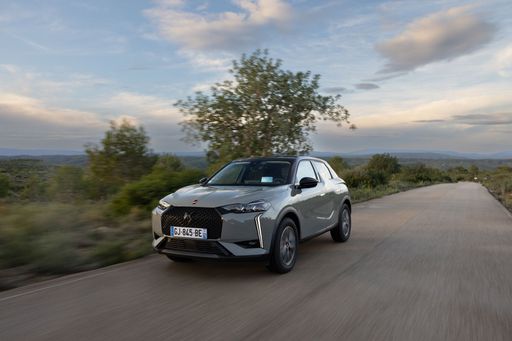 @ media.stellantis.com
@ media.stellantis.com
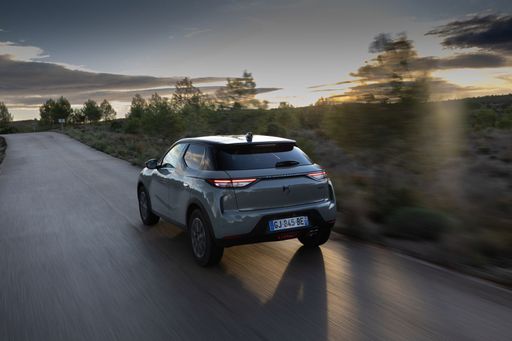 @ media.stellantis.com
@ media.stellantis.com
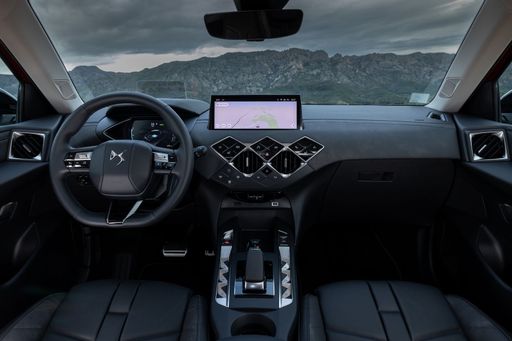 @ media.stellantis.com
@ media.stellantis.com

|

|
|
|
|
Costs and Consumption |
|
|---|---|
|
Price
25700 - 41600 £
|
Price
28400 - 40500 £
|
|
Consumption L/100km
4.8 - 5.4 L
|
Consumption L/100km
5 L
|
|
Consumption kWh/100km
15.1 - 17.5 kWh
|
Consumption kWh/100km
15.50 kWh
|
|
Electric Range
344 - 410 km
|
Electric Range
400 km
|
|
Battery Capacity
0.4 - 51 kWh
|
Battery Capacity
51 kWh
|
|
co2
0 - 119 g/km
|
co2
0 - 112 g/km
|
|
Fuel tank capacity
44 - 45 L
|
Fuel tank capacity
44 L
|
Dimensions and Body |
|
|---|---|
|
Body Type
SUV
|
Body Type
SUV
|
|
Seats
5
|
Seats
5
|
|
Doors
5
|
Doors
5
|
|
Curb weight
1380 - 1689 kg
|
Curb weight
1249 - 1646 kg
|
|
Trunk capacity
340 - 415 L
|
Trunk capacity
350 L
|
|
Length
4173 mm
|
Length
4118 mm
|
|
Width
1781 mm
|
Width
1791 mm
|
|
Height
1505 - 1538 mm
|
Height
1534 mm
|
|
Max trunk capacity
1205 - 1280 L
|
Max trunk capacity
1050 L
|
|
Payload
390 - 420 kg
|
Payload
362 - 466 kg
|
Engine and Performance |
|
|---|---|
|
Engine Type
Electric, Petrol MHEV
|
Engine Type
Electric, Petrol MHEV
|
|
Transmission
Automatic
|
Transmission
Automatic
|
|
Transmission Detail
Dual-Clutch Automatic, Reduction Gearbox
|
Transmission Detail
Reduction Gearbox, Dual-Clutch Automatic
|
|
Drive Type
Front-Wheel Drive, All-Wheel Drive
|
Drive Type
Front-Wheel Drive
|
|
Power HP
136 - 280 HP
|
Power HP
145 - 156 HP
|
|
Acceleration 0-100km/h
5.9 - 9.1 s
|
Acceleration 0-100km/h
9.1 - 9.2 s
|
|
Max Speed
150 - 206 km/h
|
Max Speed
150 - 196 km/h
|
|
Torque
230 - 345 Nm
|
Torque
230 - 260 Nm
|
|
Number of Cylinders
3
|
Number of Cylinders
3
|
|
Power kW
100 - 207 kW
|
Power kW
107 - 115 kW
|
|
Engine capacity
1199 cm3
|
Engine capacity
1199 cm3
|
General |
|
|---|---|
|
Model Year
2024 - 2025
|
Model Year
2024 - 2025
|
|
CO2 Efficiency Class
A, C, D
|
CO2 Efficiency Class
A, C
|
|
Brand
Alfa Romeo
|
Brand
DS Automobiles
|
What drive types are available for the Alfa Romeo Junior?
Available configurations include Front-Wheel Drive or All-Wheel Drive.
The prices and data displayed are estimates based on German list prices and may vary by country. This information is not legally binding.
